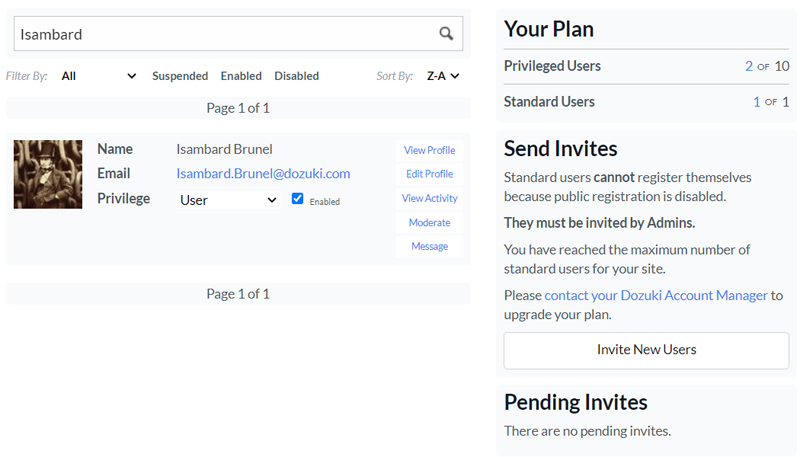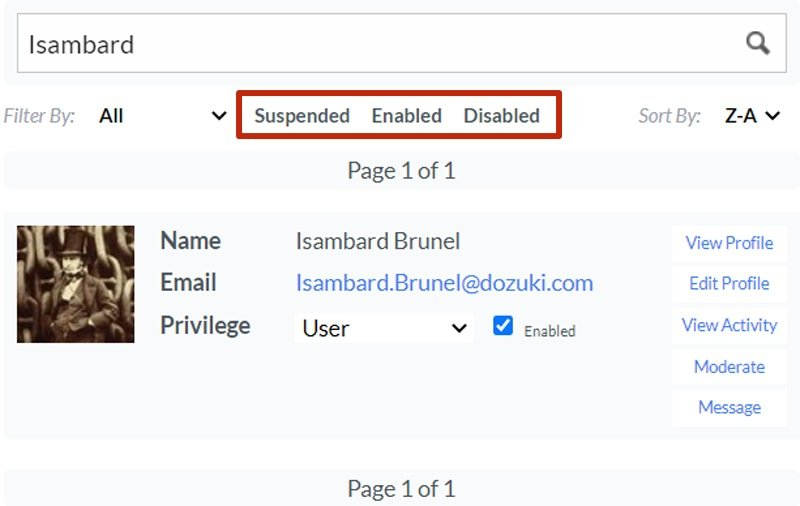Managing Users
Overview
User Info is part of the Management Console, located in /Manage, and it allows administrators to invite, search, view, edit, message and moderate all users on the site.
Learn more about the different functions of the Management Console here.
User Types
User Plan
Your User Plan shows you how many user licenses are allocated to your site.
- Privileged Users are users with Admin, Author or Moderator privileges.
- Standard Users do not have special privileges for viewing or editing site content.
Standard Users
Standard users are primarily the "end-users" of a site. Typically, they are operators, technicians, and shop-floor employees who need to view content, but they only interact with the pages in a limited and controlled manner.
Standard users can:
- View public content on a site.
- Post comments to pages where Comments are allowed.
- Enter data on guides with Data Capture activated.
- View and edit their own profile.
- Join and leave public (non-invite-only) user Teams.
- Be assigned as an Approver for an Approval Process (and therefore be allowed temporary access to private content to fulfill the approval request)
Standard users cannot:
- View private content on a site.
- View the site Management Console.
- Create teams or join invite-only teams.
- Create, edit, publish or delete site content.
- View page history.
- Create or assign Approval Processes.
Authors
Authors have all the privileges of standard users in addition to the ability to create, edit, and publish any site content and view limited areas of the Management Console.
In addition to standard user privileges, Authors can:
- View public and private content.
- Create, edit, and publish any site content.
- View page history.
- Create Teams.
- View limited areas of the Management Console (including the Category Manager, Site Explorer & Site Reports).
- Use the Patrol moderation feature for public sites allowing public editing.
Authors cannot:
- Delete site content
- Create or assign Approval Processes.
- Invite users or edit user profiles/information.
- Change site configuration or billing information
Moderators
Moderators are a user type that is only supported for Dozuki sites with an Answers page activated. Moderators also play a role in sites with Public Editing enabled (allowing any user to contribute to site content).
Moderators hold the role of moderating questions, moderating answers and comments on the Answers page, and approving or rejecting suggested edits by the community of users contributing to the site. This ensures that unwanted content does not go live on the site without review and approval.
Moderators can create pages; however, they cannot edit or delete live content on the site or view Guide Page History. Moderators also cannot view Private content on a site.
You can also set a "Moderator & Author" as a user type, which allows all privileges of both Authors and Moderators.
Admins
Site admins have access to everything on the site, including viewing and changing site billing information, maintaining site configuration settings, creating and assigning Approval Processes, and editing any user settings and profiles.
Adding New Users
For private sites (not open for public registration), users must be added by invitation by site administrators.
Sending User Invitations
To add new users, click on the Invite New Users button on the User Info page. You can select the user privilege preference and enter the email address for the future user. Multiple users can be invited at one time by entering multiple email address, separated by comma. Note: You can only add multiple users of the same privilege.

View our Step-by-Step Guide to Adding Users for more detailed information.
Pending Invitations
Once a user invitation is sent, it appears under the "Pending Invites" section of the User Info page until the invited user accepts the invitation. Pending invites can be resent as a reminder or revoked if necessary.
Account Creation
An invited user receives an email with a link to accept their invitation. Upon clicking this link, the user is prompted to create a user account (selecting a username and creating a password) before accessing the site.
Finding a User
There are multiple methods to find users, depending on if you are searching for a specific user or if you want to browse users with a particular privilege.
Using the Search Bar
If you know a user's account name, email address, or user ID you may search for them directly. You do not need to know their exact name or email for them to show up in the search results. For example, if you're looking for Isambard Brunel, whose email is Isambard.Brunel@dozuki.com, you can search for Isambard. Be warned: all users with "Isambard" in their account name or email address will appear in the search results as well.''
If you type in a number by itself in the search bar, it will only return the user with that exact ID.

Browsing by Privilege
To narrow your search or browse through a specific group of members, privilege filters are below the search bar. Perhaps you know that Isambard is a standard user, so in addition to searching for "Isambard" using the search bar, you might select "User" to hide all of the users named Isambard who are not users.

You may also use these filters to browse through all users or the users who have been banned or disabled. For more information, scroll down to Disabling Users.

Administrator Actions
User Info is also an efficient tool for administrator actions, such as changing privileges, moderating members, and sending messages.

Editing Privileges
The drop-down privilege menu allows you to easily edit a user's privilege. You may remove administrator privileges from accounts that no longer need them, add moderator or administrator privileges, or purchase more administrator privileges.
Editing Profiles
Sometimes it is necessary to moderate the actual user profiles, in which case Admins have the ability to edit a user's profile at any time.
Disabling Users
If they no longer need or should have access to the site, users can be disabled. Users are disabled by unchecking the "Enabled" box next to the user's privilege selector. Disabling allows you to remove that user from your User Plan (freeing up a user license), without affecting the site history.
You can view all disabled users on a site by clicking on the Disabled button:

Large sites with many users or sites that have been active for a while tend to accumulate a high amount of disabled users over time. To only show enabled users, click on the Enabled button as the filter option:

Note: Disabling a user is recommended over "re-using" user accounts by changing the user account information (name, email, password), as this method poses a risk to the pages created by the original user. For example, if you change Tyler's account into Carl's new account, as seen in the above image, any pages authored by Tyler would automatically change to show Carl as the author. Likewise, all of Tyler's history would now show as Carl's.
Moderating Users
All online communities and forums have rules and guidelines, and there are consequences for breaking them. The Moderate button opens a menu of moderation actions. Each moderation action includes a description of what happens when it is applied to a user. The actions range from removing reputation points to banning a member for whatever amount of time is deemed appropriate.

Banning Users
Though the other moderation tools are more self-explanatory, there is a lot more to banning someone than meets the eye. Banning a member should be a last resort option. Banning should only be exercised when someone shows a complete lack of desire to comply with the site rules and/or guidelines.
Banning invalidates a user's login for a specified amount of time. That person will automatically be logged out and will not be able to log in or have any interaction on the site.
If the banned user attempts to log in again, the message "This account has been temporarily suspended" displays and the login attempt will be denied. Once the duration specified by the banning administrator has elapsed, the user's email address becomes valid and login/community interaction are restored.
Sending a Message
The Message button for each user allows an administrator to send an email to the email address provided by that user. Contacting a user directly should come before any moderating action against a user, unless the user's actions are especially flagrant or offensive.
Was this article helpful to you?
Didn't find the answer you were looking for?
Ask a QuestionYour vote has been recorded.
Tell us more. (optional)
